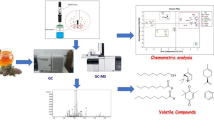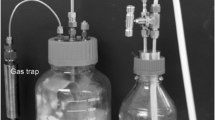Abstract
Replicates of whole colonies of four species of closely related dermatophytes were analyzed by pyrolysis gas-liquid chromatography (PGLC). The four species included fifteen strains of Arthroderma tuberculatum, and two strains each of A. benhamiae, Nannizzia gypsea and N. incurvata.
Individual/peaks on different pyrograms were identified as homologous with the aid of internal markers by the superimposition of pyrograms. The peak height data extracted from the pyrograms of the fungal samples were analyzed to compute average similarities between pairs of pyrograms. The average was calculated with each peak weighted equally, and log weighted for its information content. The results of the cluster analyses of proximities were generally similar.
Most, but not all, replicates of each strain were similar enough to be clustered together. Some strains belonging to the same species were also similar enough to be grouped in one cluster. Other strains of a single species varied sufficiently to be put in separate clusters. The nearest neighbour to each OTU (pyrogram) was always a replicate of the same strain.
Similar content being viewed by others
References
Carmichael, J. W. 1963. Dried mold colonies on cellophane. Mycologia 55: 283–288.
Carmichael, J. W. & P. H. A. Sneath. 1969. Taxometric maps. Syst. Zool. 18: 402–415.
Carmichael, J. E. 1970. The taxmap classification program, Univ. Alberta Mold Herb. mimeogr., Edmonton, Alta., Can.
Carmicael, J. E., A. S. Sekhon & L. Sigler. 1973. Classification of some dermatophytes by pyrolysis gas-liquid chromatography. Can. J. Microbiol. 19: 403–407.
Carmone, F. J. 1969. Department of Economics, University of Waterloo, Waterloo, Ontario, Canada.
Cone, R. D. & R. V. Lechowick. 1970. Differentiation of Clostridium botulinum types A, B and E by pyrolysis gas-liquid chromatography. Appl. Microbiol. 19: 138–145.
Davison, W. H. T., S. Slaney & A. L. Wragg. 1954. A novel method of identification of polymers. Chem. and Ind. 1356.
Griffin, D. M. 1960. Perfect stage of Microsporum gypseum. Nature 186: 94–95.
Ghani, H. M., J. H. Lancaster & H. W. Larsh. 1975. Chromatographic separation of pigments produced by Arthroderma benhamiae. Sabouraudia 13: 89–93.
Hall, R. C. & W. Bennett. 1973. Pyrolysis gas chromatography of several cockroach species. J. Chromatogr. Sci. 11: 439–443.
Harley, R. M. & M. G. Bell. 1967. Taxonomic analysis of hebarium material by gas chromatography. Nature 213: 1241–1242.
Janik, A. 1975. What is the best measure of the detector signal: The peak area or the peak height. J. Chromatogr. Sci. 13: 93–96.
Kruskal, J. B. 1964. Multidimensional scaling by optimizing goodness of fit to a nonmetric pyrothesis. Psychometrika 29: 1–27.
Kruskal, J. B. 1964. Nonmetric multidimensional scaling: a numerical method. Psychometrika 29: 115–129.
Kruskal, J. B. 1969. Author multidimensional scaling, Bell Telephone Laboratories, Murray Hill, N.J.
Kulik, M. M. & P. G. Vincent. 1973. Pyrolysis gasliquid chromatography of fungi: observations on variability among nine Penicillium species of the section Asymmetrica, subsection Fasciculata. Mycopathol. et Mycol. appl. 51: 1–18.
Levy, R. L. 1967. Trends and advances in design of pyrolysis units for gas chromatography. J. Gas Chromatog. 5: 107–113.
Meuzelaar, H. L. C. & R. A. Huis In 't Veld. 1972. A technique for curie point pyrolysis gas chromatography of complex biological samples. J. Chromatogr. Sci. 10: 213–216.
Meuzelaar, H. L. C., H. C. Ficke & H. C. den Horink. 1975. Fully automated curie point pyrolysis gas-liquid chromatography. J. Chromatogr. Sci. 13: 12–17.
Myers, A. & L. Watson. 1969. Rapid diagnosis of viral and fungal diseases in plants by pyrolysis and gas-liquid chromatography. Nature 223: 964–965.
Nannizzi, A. 1927. Ricerche sull'origin saprofitica dei funghi delle tigne. II. Symnoascus gypseum (Bodin) ota et langeron. Atti. Accad. Fisiocr. Siena 10: 89–97.
Oyama, V. I. & G. C. Carle. 1967. Pyrolysis gaschromatography application to life detection and chemotaxonomy. J. Gas Chromatog. 5: 151–154.
Oxborrow, G. S., N. D. Fields & J. R. Puleo. 1977. Pyrolysis Gas-liquid Chromatography of the genus Bacillus: Effect of Growth media on pyrochromatogram reproducibility. Appl. Environ. Microbiol. 33: 865–870.
Reiner, E. 1965. Identification of bacterial strains by pyrolysis gas-liquid chromatography. Nature 206: 1272–1274.
Reiner, E. 1967. Studies on differentiation of microorganisms by pyrolysis gas-liquid chromatography. J. Gas Chromatog. 5: 65–67.
Reiner, E. & W. H. Ewing. 1968. Chemotaxonomic studies of some gram negative bacteria by means of pyrolysis gasliquid chromatography. Nature 217: 191–194.
Reiner, E. & G. P. Kubica. 1969. Predictive value of pyrolysis gas-liquid chromatography in the differentiation of mycobacteria. AM. Rev. of Respir. Dis. 99: 42–49.
Reiner, E., R. E. Beam & G. P. Kubica. 1969. Pyrolysis gas-liquid chromatography studies for the classification of mycobacteria. AM. Rev. of Respir. Dis. 99: 750–759.
Reiner, E., J. J. Hicks, M. M. Ball & W. J. Martin. 1972. Rapid characterization of Salmonella organisms by means of pyrolysis gas-liquid chromatography. Anal. Chem. 44: 1058–1061.
Reiner, E. & J. J. Hicks. 1972. Differentiation of normal and pathological cells by pyrolysis gas-liquid chromatography. Chromatographia 5: 525–528.
Rippon, J. W. & E. D. Garber. 1969. Dermatophyte pathogenicity as a function of mating type and associated enzymes. J. Invest. Derm. 53: 445–448.
Rippon, J. W. 1971. Differences between + and − strains of keratinophilic fungi. Rec. Adv. in Microbiol., 31: 473–475.
Sekhon, A. S. & J. W. Charmichael. 1972. Pyrolysis gas-liquid chromatography of some dermatophytes. Can. J. Microbiol. 18: 1593–1601.
Sekhon, A. S. & J. W. Carmichael. 1973. Column variation affecting a pyrolysis gas-liquid chromatographic study of strain variation in two species of Nannizzia. Can. J. Microbiol. 19: 409–411.
Sekhon, A. S., A. A. Padhye & J. W. Carmichael. 1974. Disc-gel electrophoresis of (+) and (−) strains and of the gymnothecial cultures of Arthroderma tuberculatum. Sabouraudia 12: 12–17.
Sekhon, A. S. & J. W. Carmichael. 1975. Classification of some Gymnoascaceae by pyrolysis gas-liquid chromatography by using added marker compounds. Sabouraudia 13: 83–88.
Seviour, R. J., G. A. Chilvers & W. D. Crow. 1974. Characterization of eucalypt mycorrhizas by pyrolysis gas chromatography. New Phytol. 73: 321–332.
Shechter, Y., J. W. Ladau, N. Dabrowa & V. D. Newcomer. 1968a. Disc electrophoretic studies of intraspecific variability of proteins from dermatophytes. Sabouraudia 6: 133–137.
Shechter, Y., J. W. Landau, N. Dabrowa & V. D. Newcomer. 1968b. Biochemical taxonomy of the dermatophytes. J. Invest. Derm., 51: 165–169.
Silva, M. 1953. Nutritional studies of the dermatophytes: Factors affecting pigment production. Trans. N.Y. Acad. Sci. 15: 106–110.
Simmonds, P. G., 1970. Whole microorganisms studied by pyrolysis gas chromatography-mass spectrometry: significance for extra-terrestrial detection experiments. Appl. Microbiol. 20: 567–572.
Stockdale, P. M. 1961. Nannizzia incurvata gen. nov., a perfect state of Microsporum gypseum (Bodin), Guiart et Grigorakis. Sabouraudia 1: 41–48.
Author information
Authors and Affiliations
Rights and permissions
About this article
Cite this article
Brosseau, J.D., Carmichael, J.W. Pyrolysis gas-liquid chromatography applied to a study of variation in Arthroderma tuberculatum. Mycopathologia 63, 67–79 (1978). https://doi.org/10.1007/BF00441251
Issue Date:
DOI: https://doi.org/10.1007/BF00441251




